HP Compaq Presario SR2150NX, Compaq Presario SR2163WM, Compaq Presario SR2168HM, Compaq Presario SR2170NX, Compaq Presario SR2172NX Getting Started Guide
...Getting Started
The only warranties for Hewlett-Packard products and services are set forth in the express statements accompanying such products and services. Nothing herein should be construed as constituting an additional warranty. HP shall not be liable for technical or editorial errors or omissions contained herein.
HP assumes no responsibility for the use or reliability of its software on equipment that is not furnished by HP.
This document contains proprietary information that is protected by copyright. No part of this document may be photocopied, reproduced, or translated to another language without the prior written consent of HP.
Hewlett-Packard Company
P.O. Box 4010
Cupertino, CA 95015-4010
USA
Copyright © 2000–2006 Hewlett-Packard Development Company, L.P.
May be licensed in the United States by one or both of U.S. Patents Nos. 4,930,158 and 4,930,160 until August 28, 2008.
Microsoft and Windows Vista are U.S. registered trademarks of Microsoft Corporation.
The Windows logo and Windows Vista are trademarks or registered trademarks of Microsoft Corporation in the United States and/or other countries/regions.
HP supports lawful use of technology and does not endorse or encourage the use of our products for purposes other than those permitted by copyright law.
The information in this document is subject to change without notice.
Table of Contents
Setting Up Your Computer........................................................................ |
1 |
Putting Your Computer Together ............................................................................... |
1 |
Placing the computer in the proper location .......................................................... |
1 |
Using surge protection ....................................................................................... |
2 |
Connecting to the computer ................................................................................ |
2 |
Connecting a Digital Camera (Photo or Video)........................................................... |
4 |
Connecting Other Devices ....................................................................................... |
5 |
Storing Documentation and Recovery Discs................................................................ |
6 |
Adjusting the Monitor.............................................................................................. |
6 |
Setting Up a Local Area Network ............................................................................. |
6 |
Setting Up a Wired (Ethernet) Connection ................................................................. |
8 |
Integrated Wireless Devices..................................................................................... |
8 |
Connecting the Wireless LAN Device........................................................................ |
9 |
Checking the wireless LAN device installation ..................................................... |
10 |
Using wireless security features ......................................................................... |
10 |
Connecting a Modem ........................................................................................... |
11 |
Connecting Speakers or Microphone ...................................................... |
13 |
Using Speakers .................................................................................................... |
13 |
Sound Connector Types ........................................................................................ |
14 |
Connecting a Microphone ..................................................................................... |
16 |
Speaker Configurations......................................................................................... |
16 |
Speaker types ................................................................................................. |
17 |
Connecting 2/2.1 (Two Speakers and a Subwoofer) Audio Speakers......................... |
18 |
Connecting 4.1 (Four Speakers and a Subwoofer) Audio Speakers ............................ |
19 |
Connecting 5.1 (Five Speakers and a Subwoofer) Audio Speakers............................. |
20 |
Connecting 7.1 (Seven Speakers and a Subwoofer) Audio Speakers .......................... |
22 |
Table of Contents |
iii |
Connecting the Computer to a Home Audio System .................................................. |
24 |
Y adapter cables ............................................................................................. |
24 |
2.1 home stereo installation .............................................................................. |
25 |
5.1 home audio installation .............................................................................. |
26 |
5.1 home audio installation procedure............................................................... |
26 |
7.1 home audio installation .............................................................................. |
28 |
7.1 home audio installation procedure............................................................... |
29 |
Connecting Digital Audio ...................................................................................... |
30 |
Connecting Headphones ....................................................................................... |
31 |
Using a 2.1 speaker system with headphones ..................................................... |
31 |
Using a 5.1 to 7.1 speaker system with headphones ........................................... |
31 |
Connecting Speakers Using the Creative Sound Blaster X-Fi Sound Card ..................... |
32 |
Connecting the speakers .................................................................................. |
32 |
Connecting the FlexiJack connector.................................................................... |
33 |
Getting Help .......................................................................................... |
35 |
Finding Onscreen Guides...................................................................................... |
35 |
Finding Guides on the Web................................................................................... |
35 |
Using the Onscreen Help and Support Center .......................................................... |
36 |
Using the PC Help & Tools Folder ........................................................................... |
36 |
Using HP Connections or Compaq Connections ....................................................... |
36 |
Getting messages ............................................................................................ |
37 |
Turning off messages ....................................................................................... |
37 |
Reactivating messages ..................................................................................... |
38 |
Turning On Your Computer for the First Time .......................................... |
39 |
Using the Computer with Safety and Comfort........................................................... |
39 |
Protecting Your Computer...................................................................................... |
40 |
Using passwords ............................................................................................. |
40 |
Using antivirus software.................................................................................... |
42 |
Using firewall software..................................................................................... |
42 |
Installing critical security updates....................................................................... |
43 |
Turning On Your Computer for the First Time............................................................ |
43 |
Turning Off Your Computer.................................................................................... |
44 |
Using Shut Down............................................................................................. |
44 |
Using Lock ...................................................................................................... |
44 |
Using sleep mode............................................................................................ |
45 |
Using hibernate mode ...................................................................................... |
46 |
Automatic sleep, hibernate, or away mode......................................................... |
46 |
Restarting the Computer ........................................................................................ |
47 |
Connecting to the Internet...................................................................................... |
47 |
Signing Up for Software Updates ........................................................................... |
48 |
iv Getting Started
Setting Up User Accounts on Your New Computer.................................................... |
49 |
Creating passwords ......................................................................................... |
49 |
Guidelines for Installing Software and Hardware Devices.......................................... |
50 |
Transferring Files and Settings from Your Old Computer to Your New Computer .......... |
51 |
Using HP Total Care Advisor Software .................................................................... |
51 |
Using the Keyboard............................................................................... |
53 |
Identifying Keyboard Features................................................................................ |
53 |
Alphanumeric keys .......................................................................................... |
53 |
Function keys .................................................................................................. |
54 |
Edit keys......................................................................................................... |
54 |
Arrow keys ..................................................................................................... |
54 |
Numeric keys.................................................................................................. |
55 |
Keyboard indicators ........................................................................................ |
55 |
Special keyboard buttons ................................................................................. |
56 |
Identifying Special Keyboard Buttons ...................................................................... |
56 |
Customizing the keyboard buttons ..................................................................... |
59 |
Keyboard Shortcuts............................................................................................... |
59 |
Using the Mouse .................................................................................... |
61 |
Using the Mouse Buttons ....................................................................................... |
61 |
Scrolling......................................................................................................... |
62 |
Autoscrolling................................................................................................... |
62 |
Panning.......................................................................................................... |
62 |
Switching Mouse Button Functions .......................................................................... |
63 |
Changing Mouse Pointer Speed ............................................................................. |
63 |
Introducing Your Computer Software ..................................................... |
65 |
Learning More About Software............................................................................... |
65 |
Using the Desktop................................................................................................. |
65 |
Removing desktop icons ................................................................................... |
66 |
Retrieving desktop icons ................................................................................... |
66 |
Using the Windows Start Button Menu .................................................................... |
66 |
Using the All Programs menu ............................................................................ |
66 |
Organizing your All Programs list...................................................................... |
67 |
Using the Control Panel......................................................................................... |
67 |
Resizing Windows................................................................................................ |
68 |
Working with Digital Images ................................................................................. |
68 |
About the Internet ................................................................................................. |
69 |
Using a Browser................................................................................................... |
70 |
Searching the Internet ...................................................................................... |
70 |
Restricting Internet content................................................................................. |
71 |
Table of Contents |
v |
Using Antivirus Software ....................................................................................... |
71 |
Configuring and registering Norton Internet Security software ............................... |
72 |
Changing the virus scan time for your Norton Internet Security program ................. |
72 |
Sending and Receiving E-Mail................................................................................ |
73 |
Using Windows Mail ....................................................................................... |
73 |
Using the e-mail program provided by your ISP ................................................... |
73 |
Software Quick Reference Table............................................................................. |
74 |
Managing Files ...................................................................................... |
77 |
Organizing Files with Folders................................................................................. |
77 |
Creating Folders................................................................................................... |
78 |
Moving Files ........................................................................................................ |
78 |
Finding Files ........................................................................................................ |
79 |
Renaming Files..................................................................................................... |
79 |
Deleting Files ....................................................................................................... |
80 |
Retrieving Files from the Recycle Bin ....................................................................... |
80 |
Copying Files....................................................................................................... |
80 |
Using a Printer ..................................................................................................... |
81 |
Using CD and DVD Media Drives ............................................................ |
83 |
Using Your CD and DVD Drives ............................................................................. |
83 |
Handling CDs and DVDs .................................................................................. |
83 |
Inserting and removing CDs and DVDs............................................................... |
84 |
Compatibility Information ...................................................................................... |
85 |
Disc Features and Compatibility Table .................................................................... |
86 |
Optical Drive Quick Reference Table ...................................................................... |
87 |
Using the Memory Card Reader ............................................................. |
89 |
Media Insertion Guide .......................................................................................... |
90 |
Understanding the Activity Light ............................................................................. |
93 |
Formatting a Memory Card ................................................................................... |
93 |
Troubleshooting the Memory Card Reader............................................................... |
94 |
Using the HP Personal Media Drive and HP Pocket Media Drive ............. |
95 |
Connecting the Drive ............................................................................................ |
96 |
Inserting the Drive into an HP drive bay................................................................... |
96 |
Connecting the Drive to a Computer Without a Drive Bay ......................................... |
97 |
Locating the Drive and Assigning a Drive Letter ........................................................ |
98 |
Using the Drive .................................................................................................... |
99 |
Transferring files to another computer manually ................................................... |
99 |
Disconnecting the Drive....................................................................................... |
100 |
Troubleshooting the HP Media Drive ..................................................................... |
101 |
vi Getting Started
Playing CDs, DVDs, or VCDs ................................................................. |
103 |
Playing Music CDs ............................................................................................. |
103 |
Playing CDs with Windows Media Player.............................................................. |
103 |
Playing DVDs..................................................................................................... |
104 |
Using country/region codes............................................................................ |
104 |
Playing DVDs with Windows Media Player............................................................ |
104 |
Playing Video CDs (VCDs)................................................................................... |
105 |
Playing Video CDs (VCDs) with Windows Media Player.......................................... |
105 |
Creating Audio and Data Discs............................................................. |
107 |
Erasing Rewritable Discs Before Recording ............................................................ |
108 |
Working with Audio CDs .................................................................................... |
108 |
Audio CD tips ............................................................................................... |
109 |
Before you begin creating discs....................................................................... |
109 |
Creating audio CDs ....................................................................................... |
109 |
Creating jukebox discs ................................................................................... |
110 |
Creating video discs ...................................................................................... |
110 |
Copying a disc ............................................................................................. |
111 |
Creating data discs........................................................................................ |
112 |
Creating photo (slide show) discs .................................................................... |
112 |
Making a disc label using LightScribe .............................................................. |
113 |
Making a paper disc label.............................................................................. |
114 |
Creating Movies by Using muvee autoProducer.................................... |
115 |
Basic Steps to Make a Movie............................................................................... |
115 |
Using muvee autoProducer .................................................................................. |
116 |
Getting started .............................................................................................. |
116 |
Capturing video from a digital video camera .................................................... |
118 |
Adding videos............................................................................................... |
119 |
Adding pictures............................................................................................. |
120 |
Adding music................................................................................................ |
121 |
Selecting the style .......................................................................................... |
121 |
Changing the settings..................................................................................... |
122 |
Adding an opening title and closing credits ...................................................... |
123 |
Making the movie.......................................................................................... |
123 |
Previewing the movie ..................................................................................... |
124 |
Modifying the movie ...................................................................................... |
124 |
Saving the movie project ................................................................................ |
125 |
Recording the movie project to disc ................................................................. |
126 |
Upgrading muvee autoProducer ........................................................................... |
127 |
Index................................................................................................... |
129 |
Table of Contents |
vii |
viii Getting Started

Setting Up Your Computer
WARNING: The power supply is preset for the country/region in which you purchased your computer. If you move, please check the voltage requirements before plugging your computer into an AC power outlet.
WARNING: Please read “Safety Information” in the Warranty and Support Guide before installing and connecting your computer to the electrical power system.
Putting Your Computer Together
Follow the steps on the setup poster to set up your computer. Read the topics in this section to learn more about the location of components and connectors on your computer, and to learn about some setup alternatives.
Look in the computer box for printed details or updates regarding your computer.
Placing the computer in the proper location
When setting up your new computer, place it where ventilation openings are unobstructed. Make sure all connections are secure and all cabling is out of the way. Do not place cables in walkways or where it can be stepped on or damaged from placing
furniture on it.
Setting Up Your Computer 1
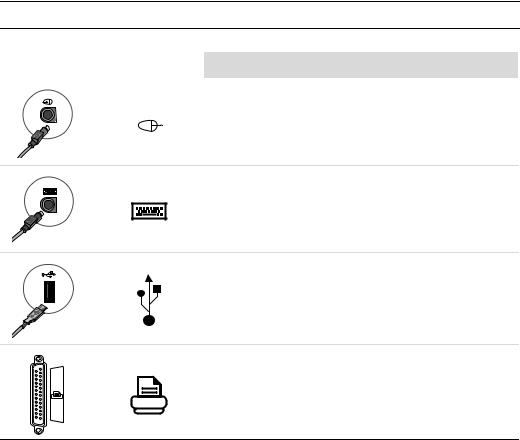
Using surge protection
Help protect your monitor, computer, and accessories by connecting all power cords for your computer and peripheral devices (such as a monitor, printer, or scanner) to a surge protection device such as a power strip with surge protection or an uninterruptible power supply (UPS). Many surge protection devices have surge protection inputs and outputs for modem or telephone lines. Telephone lines are a common path for lightning spikes to get into your system. Some surge protection devices have surge protection for television cable connections as well. Use those if your computer has a television tuner installed.
Not all power strips provide surge protection; the power strip must be specifically labeled as having this capability. Use a power strip whose manufacturer offers a damage replacement policy that replaces your equipment if surge protection fails.
Connecting to the computer
Connect your main hardware devices, such as the monitor, keyboard, and mouse, to the back of the computer. Other peripheral devices, such as a printer, scanner, or camera, also plug into connectors on the back of your computer. Some computers also have connectors on the front of the computer. The table shows some, but not all, connectors.
NOTE: The location, availability, and number of connectors on your computer may vary.
Connector |
Icon/label |
Description and function |
|
|
|
Mouse (PS/2 connector)
Keyboard (PS/2 connector)
Universal Serial Bus (USB) for mouse, keyboard, digital cameras, or other devices with USB connectors
Printer (parallel)
2 Getting Started
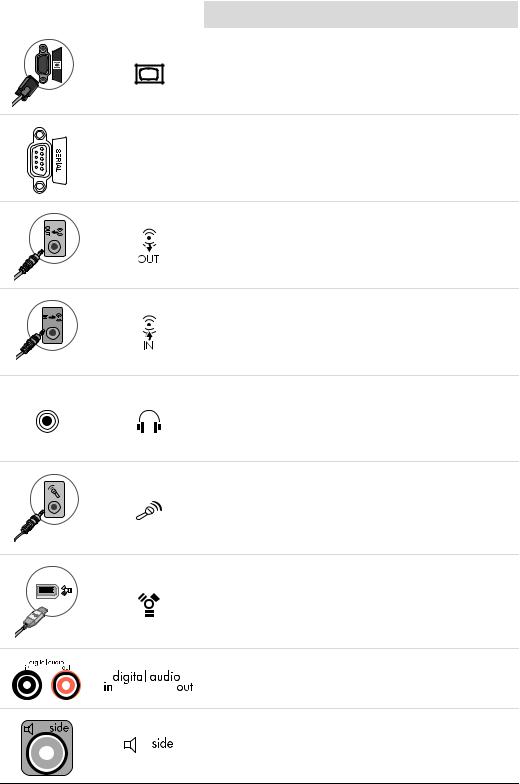
Connector |
Icon/label |
Description and function (continued) |
|
|
|
Monitor
Serial port for some digital cameras or other serial devices
Serial
Audio Line Out (powered speakers)
Audio Line In
Headphones
Microphone
FireWire® (IEEE 1394) for video cameras or other devices with very fast transfer rates
Digital audio in and digital audio out
Side speaker out
Setting Up Your Computer 3
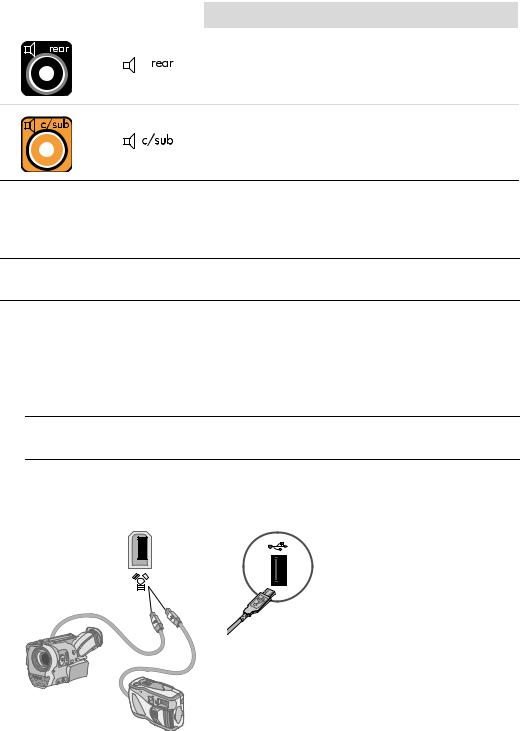
Connector |
Icon/label |
Description and function (continued) |
|
|
|
Rear speaker out
Center/subwoofer
Connecting a Digital Camera (Photo or Video)
The following instructions apply only to digital photo cameras and digital video cameras.
NOTE: When connecting an analog video camera to the computer, use the Video and Audio In connectors on the front or back of the computer.
Refer to the documentation that came with your digital photo camera or digital video camera.
To connect a digital photo camera or a digital video camera:
1Turn on the computer, and wait for Microsoft® Windows Vista™ operating system to start.
NOTE: If a Digital Video Device Auto Play window appears when you connect your camera, click Cancel.
2Connect the 6-pin video camera transfer cable into the camera and then into an open port on the front or back of the computer. Most digital video cameras use either the FireWire (IEEE 1394) port or the USB port.
3A Found New Hardware message appears. Wait 2 or 3 minutes for Windows Vista to make the necessary settings for the new device. When installation is complete, a message appears indicating the camera is ready to use.
4 Getting Started

If the computer does not recognize the digital photo camera or the digital video camera:
1Click the Windows Start Button® on the taskbar, and then click
Control Panel.
2Click System and Maintenance, and then click System.
3Click Device Manager.
4Click the plus sign (+) next to the camera port. If the name of the camera appears, the device is ready. If the name is not there, try the following:
Click Action, and then click Scan for hardware changes. Look in Device Manager for a new addition under the port.
Unplug the video camera transfer cable from the computer, and plug it into a different port. Look in Device Manager for a new addition under the port.
Connecting Other Devices
Other peripheral devices can be connected to the front or back of your computer by using USB or FireWire (IEEE 1394) ports. These peripheral devices include printers, scanners, video cameras, digital photo cameras, memory card readers, and PDAs (personal digital assistant) or handheld computers. Refer to the documentation that came with your device.
NOTE: Some peripheral devices are not included with the computer.
NOTE: You must use a 6-pin (not a 4-pin) FireWire (IEEE 1394) cable with the 6-pin
FireWire (IEEE 1394) connector on your computer.
Setting Up Your Computer 5

Storing Documentation and Recovery Discs
Store all computer user manuals and warranty information in an easy-to-find, safe location. It is a good idea to store your system recovery discs with your documentation. This allows easy access to all important computer documents and files.
Adjusting the Monitor
To change the screen resolution:
1Right-click an empty area of the desktop, and then click Personalize.
2Click the Display Settings.
3If necessary, select the monitor, and then adjust the screen resolution.
4Click Apply.
5Click Yes, if it is present.
6Click OK.
NOTE: You can connect more than one display device (CRT monitor, flat panel monitor, TV, and so on) to the computer at a time (select models only). You can quickly change which device displays the computer desktop by pressing Alt+F5. Each time you press Alt+F5, the computer desktop appears on the next device. If pressing Alt+F5 does not work, restart the computer and try again.
Setting Up a Local Area Network
Your home local area network (LAN) may consist of a wired or a wireless network that you can use to connect your computer to other devices on the network, included other computers. The network components may include a hub or a switch, which can connect multiple devices to the network, or a router, which can connect computers or a broadband Internet connection to the network. This network connection also enables you to share data, and printers or other devices among your computers. The network connection to the Internet is usually through a dial-up or cable modem.
A wired network uses Ethernet cables to connect the devices on the network. For example, the Ethernet cable plugs into your computer network interface adapter and the router.
A wireless network uses radio waves to connect the devices on the network. For example, both your computer and the router have an antenna and adapter that use the same Wi-Fi industry standard: 802.11b, 802.11g, or 802.11a.
6 Getting Started

The preceding illustration shows a home LAN. The desktop computer has a wired connection to a wireless router. The desktop computer also has a printer that it shares with the other computers on the network. Each notebook computer has a wireless connection to the network router.
Setting Up Your Computer 7
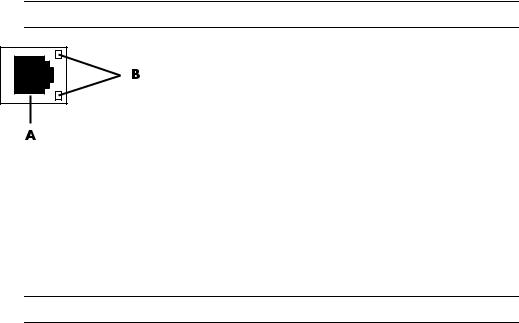
Setting Up a Wired (Ethernet) Connection
The Ethernet connection, which may be called network interface adapter, Network Interface Card, or NIC, provides a high-speed or broadband connection to an Ethernet (10BaseT) or Fast Ethernet (100BaseT) network. After you connect this interface to a network, such as a LAN, you can connect to the Internet through the network.
1Connect an Ethernet cable to the Ethernet connector (A) on the back of the computer, and to the network router or LAN device.
NOTE: Your computer may not come with an Ethernet connector.
AEthernet connector (RJ-45 port)
BEthernet indicator lights
2With the computer turned on, check the indicator lights (B) next to the Ethernet connector for the status:
ACTIVITY — Lit yellow during network data transfer activity
LINK — Lit green when there is a valid network connection
NOTE: Your Ethernet connector may have only one indicator light.
Integrated Wireless Devices
Wireless technology transfers data across radio waves instead of wires. Your computer may be equipped with one or more of the following integrated wireless devices:
Wireless local area network (WLAN) devices connect the computer to wireless local area networks (commonly referred to as wireless networks, wireless LANs, or WLANs) in corporate offices, your home, and public areas such as airports and restaurants. In a WLAN, each mobile wireless device communicates with a wireless access point, which can be several hundred feet away.
Computers with WLAN devices may support one or more of the three IEEE physical layer industry standards: 802.11b, 802.11g, or 802.11a.
Bluetooth devices create a personal area network (PAN) to connect other Bluetooth-enabled devices such as computers, phones, printers, headsets, speakers, and cameras. In a PAN, each device communicates directly with the other devices, and the devices must be relatively close together — within 33 feet (10 meters) of each other.
8 Getting Started

Wireless wide area networks (WWAN) devices provide access to information anytime and anywhere you have cellular (data) coverage. In a WWAN, each mobile device communicates to a public carrier’s base station. Public carriers install networks of base stations (similar to cell phone towers) throughout large geographic areas, effectively providing coverage across entire states, or even entire countries/regions.
For more information about wireless technology, go to:
http://www.hp.com/go/techcenter/wireless
Connecting the Wireless LAN Device
(Select models only)
You can connect the computer to an 802.11b or 802.11g wireless network by using the external antenna that was included with your system. This device enables you to establish a wireless network using your computer as a wireless access point, or you can use your computer as a wireless client (Station Mode) if you already have a wireless network running.
You need an existing wireless LAN with an Internet connection (consult your Internet Service Provider [ISP] for further information). An external antenna is supplied with your system; you must connect it to the 802.11 module to increase the range and sensitivity of the radio.
To connect the wireless LAN antenna:
1 Screw the wireless LAN antenna cable into the wireless LAN connector on the back of
the computer.
2 For the best wireless performance, place the antenna on the computer or in an elevated and open area.
NOTE: The appearance of your wireless antenna may vary.
Setting Up Your Computer 9

Checking the wireless LAN device installation
To set up your wireless network, verify that the integrated WLAN device is installed on your computer correctly.
1Click the Windows Start Button on the taskbar.
2Type Device Manager into the Search box, and then click Device Manager to open the Device Manager window.
3Click Network adapters. Your WLAN device should be listed here. The WLAN device may include the term wireless, wireless LAN, or 802.11.
NOTE: If no WLAN device is listed, either your computer does not have an integrated WLAN device, or the driver for the device is not properly installed.
4Click the Windows Start Button on the taskbar.
5Type Network and Sharing Center into the Search box, and then click Network and Sharing Center to open the Network and Sharing Center window.
6Click Add a device to the network and follow any onscreen instructions.
For more information about setting up a wireless network:
Click the Windows Start Button on the taskbar, click Help and Support, and then type Setting up a wireless network into the Search Help box.
Go to: http://www.hp.com/go/techcenter/wireless
Using wireless security features
When you set up a home WLAN or access an existing public WLAN, always enable security features to protect your network from unauthorized access. The most common security levels are Wi-Fi Protected Access Personal (WPA-Personal) and Wired Equivalent Privacy (WEP).
When setting up a network, you should use one or more of the following security measures:
Enable WPA-Personal or WEP security encryption on the router.
Change the default network name (SSID) and password.
Use a firewall.
Set security on your Web browser.
For more information about setting up wireless security features, go to: http://www.hp.com/go/techcenter/wireless
10 Getting Started
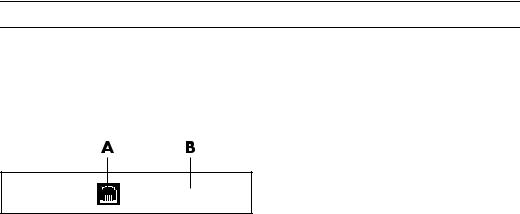
Connecting a Modem
For information on connecting to the Internet, see “Connecting to the Internet” in this guide.
The modem is used for connecting to an ISP that provides a telephone dial-up connection to the Internet.
NOTE: Your computer may not come with a modem.
Before you can use telephone dial-up to connect to the Internet and send or receive e-mail and faxes, you must connect your telephone service line to the modem (A), which is on the back of the computer (B). The setup poster shows you how to plug a modem/telephone cable into the computer modem connector and into your telephone service line wall jack connector.
A Modem connector
B Back of computer
Setting Up Your Computer 11
12 Getting Started

Connecting Speakers or Microphone
NOTE: For cross-references, see “Configuring Speaker and Sound Options” in your product information on the HP Support Web site: go to http://www.hp.com/support
Using Speakers
Speakers are included with the monitor (select models only) or are sold separately. For details on connecting stereo speakers to the computer, see the setup poster.
NOTE: Speakers may be passive (no power button and no power cord) or active (power button or power cord). Your computer supports only active (powered) speaker systems; the speaker system must have its own power cord.
A stereo speaker set is a left-right, two-channel speaker system. A multichannel audio speaker system is a system with more than two channels, and it may include a subwoofer. For example, 5.1 channels, referred to as a six-speaker mode, uses two front speakers (left-right), two rear speakers (left-right), a center speaker, and a subwoofer.
If your computer has multichannel audio speaker capacity (select models only), you can connect four channels for four-speaker output or six channels for 5.1 speaker output.
Connect your speaker system to the computer and then configure the audio software for sound output.
Connecting Speakers or Microphone 13

Sound Connector Types
Your model may include one of three analog sound connector types on the back of your computer:
Three connectors
Six connectors
Sound card
The connectors are 1/8-inch (3.5 mm) stereo mini-jacks that connect from the back of the computer to speakers and microphones.
Your system may also have a separate Digital Out connection (select models only).
Software configuration is different for each connector type, as noted in the instructions.
Sound Connector |
Illustration |
Type |
|
Three |
Your computer model may include |
|
3 |
connectors |
three sound connectors. You can |
|
|
|
connect up to a 5.1 audio system to the |
|
|
|
computer. |
|
|
Six |
Your computer model may include six |
|
6 |
connectors |
sound connectors on the back of your |
|
|
|
computer. You can connect up to a 7.1 |
|
|
|
audio system to the computer. |
|
|
Sound card |
Your computer may include a sound |
See the following |
S |
connector |
card. You can connect up to a 5.1 |
illustration. |
|
|
audio system (7.1 audio system for |
|
|
|
select models) or digital speakers to the |
|
|
|
sound card on the computer. |
|
|
NOTE:
Type 3 is three connectors.
Type 6 is six connectors.
Type S is sound card.
14 Getting Started
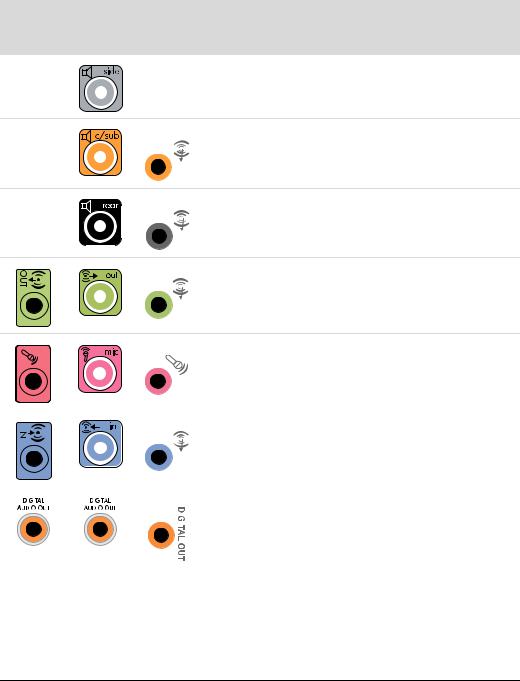
Use the sound connectors that match your computer model when installing cables, as shown in the installation procedure steps.
The following table shows the sound connectors on the back panel of computer systems.
Sound connector |
|
Type 3 Type 6 Type S |
Description |
|
Line Side (gray) for side speakers in an |
|
eight-speaker system (7.1). |
A |
Line C/Sub (gold) for center/subwoofer speakers in |
|
a multichannel audio configuration. |
B |
Line Rear (black) for rear speakers in a multichannel |
|
audio configuration. |
C |
Line Out (lime green) for front speakers. |
|
|
|
|
|
|
|
|
|
D |
|
Mic (pink) connects to microphone. |
|
|
|
|
|
|
|
|
|
|
|
(Type 3 also functions as center/subwoofer Line Out |
|
|
|
|
|
|
|
|
|
|
|
when a multichannel audio configuration is |
|
|
|
|
|
|
|
|
|
|
|
activated.) |
|
|
|
|
|
|
|
|
|
|
|
|
|
|
|
|
|
|
|
|
|
E |
|
Line In (light blue) connects to an analog audio |
|
|
|
|
|
|
|
|
|
|
|
device such as a CD player for input into computer. |
|
|
|
|
|
|
|
|
|
|
|
(Type 3 also functions as rear Line Out when a |
|
|
|
|
|
|
|
|
|
|
|
multichannel audio configuration is activated.) |
|
|
|
|
|
|
|
|
|
|
|
|
|
|
|
|
|
|
|
|
|
F |
|
Digital Out (orange) connects to a digital audio |
|
|
|
|
|
|||||||
|
|
|
|
|
|||||||
|
|
|
|
|
|
|
|
|
|
|
device with digital input (such as a home audio |
|
|
|
|
|
|
|
|
|
|
||
|
|
|
|
|
|
|
|
|
|
|
|
|
|
|
|
|
|
|
|
|
|
|
receiver/amplifier) or digital speakers |
|
|
|
|
|
|
|
|
|
|
|
(select models only). |
|
|
|
|
|
|
|
|
|
|
|
|
|
|
|
|
|
|
|
|
|
|
|
|
NOTE:
Type 3 is three connectors.
Type 6 is six connectors.
Type S is sound card.
Connecting Speakers or Microphone 15

Connecting a Microphone
Your computer comes with one microphone connector in the back of the computer. Some models have a second microphone connector in the front of the computer. Only one microphone connector works at a time, and the back connector is ready to use unless you have the multichannel audio speakers option. For computers with the multichannel audio speakers option, the microphone connector in the front of the computer, if present, is ready to use.
To use a microphone connected to the front of your computer (select models only), select the working microphone. See “Selecting a Microphone.”
HP computers support many different audio options, sound connections, and speaker configurations. You may set up your computer for two stereo speakers or for multichannel audio speaker systems. Connect your speaker system to the computer, and then configure the audio software for sound output. For more details about connecting stereo speakers to the computer, see the setup poster.
This chapter describes the most typical options. Your system may have different components.
Speakers are included with the monitor (select models only) or are sold separately.
NOTE: For additional information on connecting the speakers, refer to the setup poster that came with the computer and the documentation that came with your speakers.
Speaker Configurations
You may set up your computer for the following supported configurations:
Name |
Speaker system |
See |
|
|
|
Headphones |
None, muted. |
“Using Headphones” |
|
|
|
2 (stereo) |
Left speaker, right speaker. |
“Connecting 2/2.1 (Two Speakers and |
|
|
a Subwoofer) Audio Speakers” |
|
|
|
2.1 |
Left speaker, right speaker, |
“Connecting 2/2.1 (Two Speakers and |
|
and a subwoofer. |
a Subwoofer) Audio Speakers” |
|
|
|
4.1 |
Two front speakers, two |
“Connecting 4.1 (Four Speakers and a |
|
rear speakers, and a |
Subwoofer) Audio Speakers” |
|
subwoofer. |
|
|
|
|
6/5.1 |
Two front speakers, two |
“Connecting 5.1 (Five Speakers and a |
|
rear speakers, a center |
Subwoofer) Audio Speakers” |
|
speaker, and a subwoofer. |
|
|
|
|
16 Getting Started

Name |
Speaker system |
See (continued) |
|
|
|
8/7.1 |
Two front speakers, two |
“Connecting 7.1 (Seven Speakers and |
|
rear speakers, two side |
a Subwoofer) Audio Speakers” |
|
speakers, a center |
|
|
speaker, and a subwoofer |
|
|
(select models only). |
|
Home audio |
Home stereo or home |
system |
theater audio system with |
|
passive speakers. |
“Connecting the Computer to a Home Audio System”
Digital audio |
Digital speakers or digital |
“Connecting Digital Audio” |
|
input connector on audio |
|
|
system. |
|
|
|
|
Multi-streaming |
Two front speakers, two |
“Configuring Multi-streaming Audio” |
audio |
rear speakers, two side |
|
|
speakers, a center |
|
|
speaker, and a subwoofer |
|
|
(select models only). |
|
|
|
|
Speaker types
Speakers may be included with the monitor (select models only) or are sold separately. Refer to the product documentation for your speakers.
Your computer supports only an active (powered) speaker system. An active speaker system must have its own power cord. A home audio system does not require active speakers, because the receiver provides amplification.
A stereo speaker set is a left-right, two-channel speaker system. A multichannel audio speaker system has a left-right front and left-right rear channel, and it may include a subwoofer and a center speaker. Side speakers are included in more advanced systems. A subwoofer provides enhanced bass sounds.
“.1” indicates a subwoofer. For example, 7.1 channels refers to an eight-speaker mode and uses two front speakers (left-right), two side speakers (left-right), two rear speakers (left-right), a center speaker, and a subwoofer.
Connecting Speakers or Microphone 17
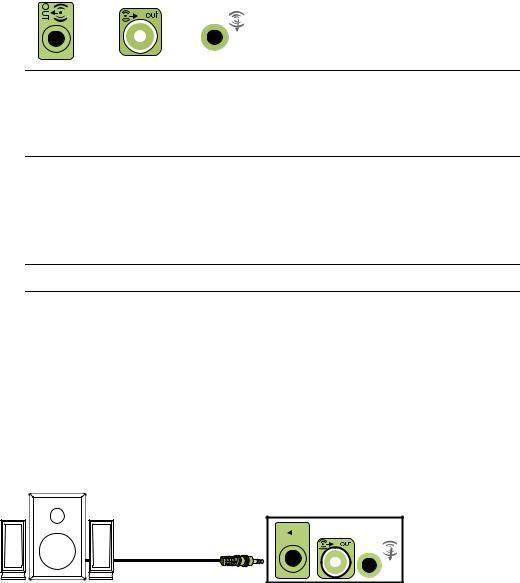
Connecting 2/2.1 (Two Speakers and a Subwoofer)
Audio Speakers
To connect simple left/right stereo active speakers or two speakers and a subwoofer for two-channel (2.1 speaker) output:
1Turn off the computer.
2Connect the speaker cable to the lime green Audio Line Out connector that matches the back of your computer.
3 |
6 |
S |
NOTE:
Type 3 is three connectors.
Type 6 is six connectors.
Type S is sound card.
3Connect the cable to the audio system. For 2.1 speakers that were shipped with your computer (select models only), connect the Audio Line Out connector to the subwoofer.
4Connect the left and right speakers to the subwoofer. Refer to the speaker documentation.
5Turn on the computer.
NOTE: Always turn on the computer before you turn on the speaker system.
6Plug in the speaker system power.
7Turn on the speaker system.
Step 8 is optional for a two-speaker setup.
8After the speakers are connected to the computer, configure the audio software for sound output for your computer model. See “Connecting Speakers or Microphone.”
Type 3: See “Configuring Audio Output with Multichannel Sound Manager.”
Type 6: See “Configuring Audio Output with Sound Effect Manager.”
Sound card: See “Configuring Audio Output with a Sound Card.”
The following diagram shows a typical 2.1 audio installation:
 OUT
OUT
18 Getting Started

Connecting 4.1 (Four Speakers and a Subwoofer)
Audio Speakers
To connect two front speakers, two rear speakers, and a subwoofer for four-channel (4.1 speaker) output:
1Turn off the computer.
2Connect the front speaker cable to the lime green Audio Line Out connector that matches the back of your computer.
3 |
6 |
S |
NOTE:
Type 3 is three connectors.
Type 6 is six connectors.
Type S is sound card.
3Connect the rear speaker cable to the black connector that matches the back of your computer.
3 |
6 |
S |
For type 3-connector systems, the blue Audio Line In connector functions as a Rear Line Out when a multichannel audio configuration is activated.
4Connect the cables to the audio system.
5Connect the front and rear speakers to the subwoofer. Refer to the speaker documentation.
6Turn on the computer.
NOTE: Always turn on the computer before you turn on the speaker system.
Connecting Speakers or Microphone 19
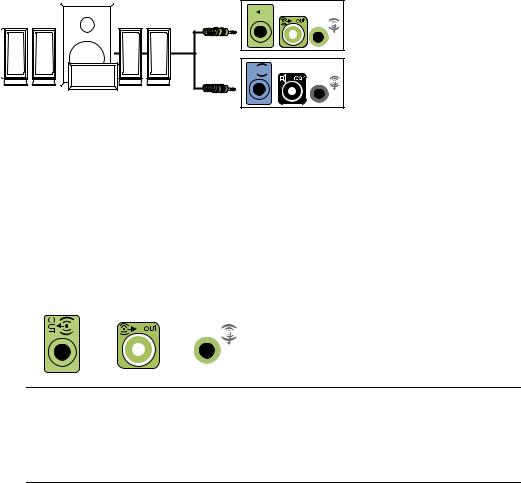
7Plug in the speaker system power.
8Turn on the speaker system.
9After the speakers are connected to the computer, configure the audio software for sound output for your computer model. See “Configuring Speaker and Sound Options.”
Type 3: See “Configuring Audio Output with Multichannel Sound Manager.”
Type 6: See “Configuring Audio Output with Sound Effect Manager.”
Sound card: See “Configuring Audio Output with a Sound Card.”
The following diagram shows a typical 4.1 audio installation:
 IN OUT
IN OUT
Connecting 5.1 (Five Speakers and a Subwoofer)
Audio Speakers
To connect two front speakers, two rear speakers, a center speaker, and a subwoofer for six-channel (5.1 speaker) output:
1Turn off the computer.
2Connect the front speaker cable to the lime green Audio Line Out connector that matches the back of your computer.
3 |
6 |
S |
NOTE:
Type 3 is three connectors.
Type 6 is six connectors.
Type S is sound card.
20 Getting Started
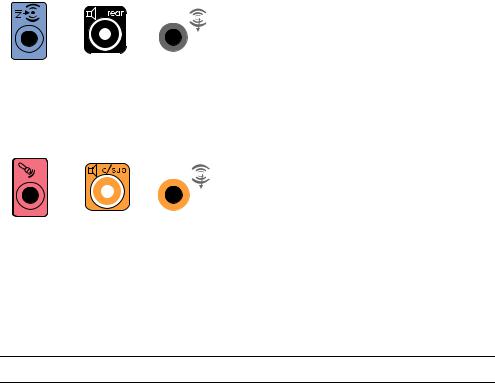
3Connect the rear speaker cable to the black connector that matches the back of your computer.
3 |
6 |
S |
For type 3-connector systems, the blue Audio Line In connector functions as a Rear Line Out when a multichannel audio configuration is activated.
4Connect the center/subwoofer speaker cable to the gold (or pink Mic) connector that matches the back of your computer.
3 |
6 |
S |
For type 3-connector systems, the pink Mic connector functions as a center/subwoofer speaker Line Out when a multichannel audio configuration is activated.
5Connect the cables to the audio system.
6Connect the front, rear, and center speakers to the subwoofer. Refer to the speaker documentation.
7Turn on the computer.
NOTE: Always turn on the computer before you turn on the speaker system.
8Plug in the speaker system power.
9Turn on the speaker system.
10After the speakers are connected to the computer, configure the audio software for sound output for your computer model. See “Configuring Speaker and Sound Options.”
Type 3: See “Configuring Audio Output with Multichannel Sound Manager.”
Type 6: See “Configuring Audio Output with Sound Effect Manager.”
Type 6 — multi-streaming: See “Configuring Audio Output with Sound Effect Manager.”
Sound card: See “Configuring Audio Output with a Sound Card.”
Connecting Speakers or Microphone 21
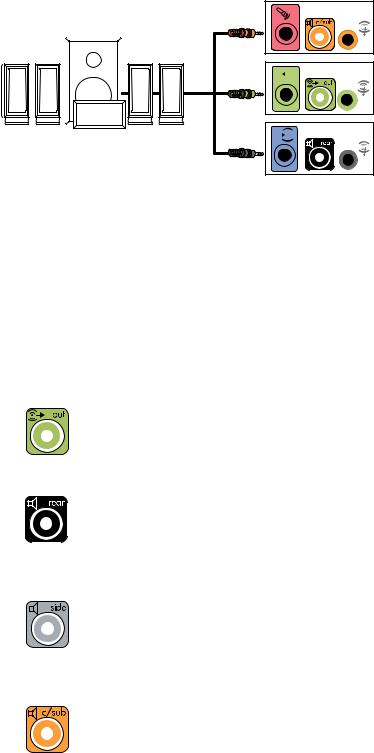
The following diagram shows a typical 5.1 audio installation:

 IN OUT
IN OUT
Connecting 7.1 (Seven Speakers and a Subwoofer)
Audio Speakers
(Select models only)
To connect two front speakers, two side speakers, two rear speakers, a center speaker, and a subwoofer for eight-channel (7.1 speaker) output:
1Turn off the computer.
2Connect the front speaker cable to the lime green Audio Line Out connector on the back of your computer.
3Connect the rear speaker cable to the black connector on the back of your computer.
4For type 6 connectors only, connect the side speaker cable to the gray connector on the back of your computer.
5Connect the center speaker and subwoofer speaker cable to the gold connector on the back of your computer.
22 Getting Started
